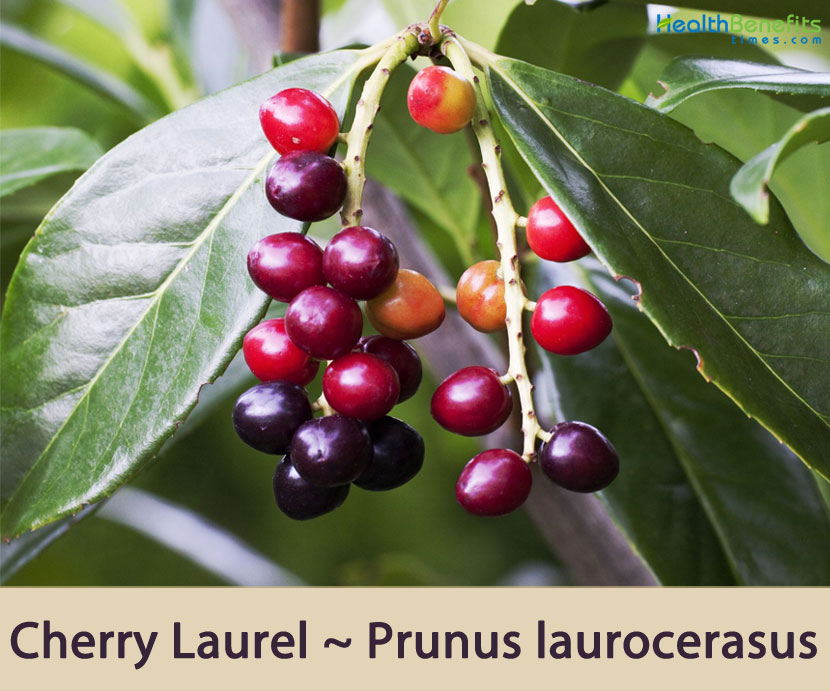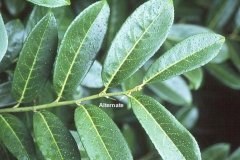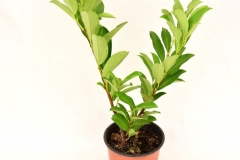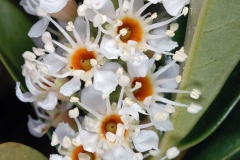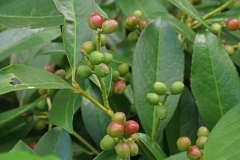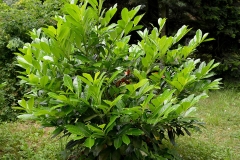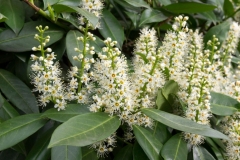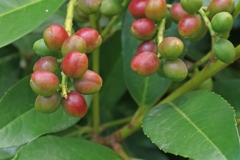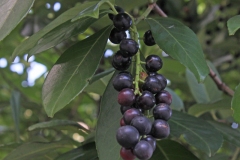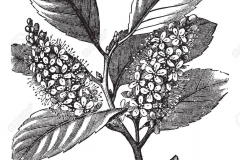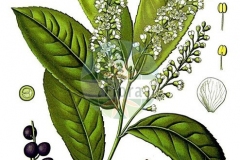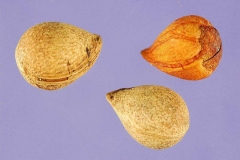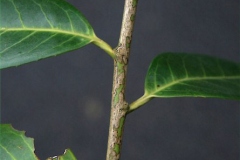Genus name Prunus comes from Latin means plum or cherry tree. Specific epithet laurocerasus means laurel cherry in reference to its laurel-like evergreen leaves and cherry-like fruit. The common names refer to the similarity of foliage and appearance to bay laurel (Laurus nobilis), and like the bay laurel, Prunus laurocerasus was used for making laurel wreaths, but the two plants are not closely related. It is not to be confused with its American relative Prunus caroliniana, which is also called cherry laurel. Cherry Laurel plants are pretty easy to grow for every type of gardener. They are tolerant of extreme light conditions, drought, aerosol salt, and even neglect. The plant is harvested from the wild for local use as a food, medicine and source of materials. The plant is widely grown as an ornamental, where selected cultivars can be used as ground cover or hedging.
Cherry Laurel Facts
| Cherry Laurel Quick Facts | |
|---|---|
| Name: | Cherry Laurel |
| Scientific Name: | Prunus laurocerasus |
| Origin | Southwestern Asia (i.e. northern Iran, Turkey, Armenia, Azerbaijan, Georgia and southern Russia) and southeastern Europe |
| Colors | Purple to black |
| Shapes | Small cherries that have 0.3 to 0.7 inches (1-2 cm) in diameter |
| Taste | Bitter, aromatic, and astringent |
| Health benefits | Beneficial for coughs, whooping cough, asthma, dyspepsia, eye infections, insomnia, stomach and intestinal spasms, vomiting, muscle spasms, pain and cancer |
| Name | Cherry Laurel |
|---|---|
| Scientific Name | Prunus laurocerasus |
| Native | Regions bordering the Black Sea in southwestern Asia (i.e. northern Iran, Turkey, Armenia, Azerbaijan, Georgia and southern Russia) and southeastern Europe , from Albania and Bulgaria east through Turkey to the Caucasus Mountains and northern Iran |
| Common Names | Cherry laurel, cherry-laurel, common cherry laurel, common laurel, English laurel, laurel, laurel cherry |
| Name in Other Languages | Abkhazian: Aşymhara (Ашымҳара) Afrikaans: Kersie lourier Albanian: Dafinë qershi Amharic: Chērī larēli (ቼሪ ላሬል) Arabic: Ghar alkurz (غار الكرز) Armenian: Bali dap’nu (բալի դափնու), dap’nekerras (դափնեկեռաս) Azerbaijani: Albalı laurel Basque: Gerezi-erramu Bengali: Cēri larēla (চেরি লরেল) Bulgarian: Chereshova lavra (черешова лавра), lavrovishnya (лавровишня), zelenika (зеленика), zimnika (зимника), lechebna lavrovishna (лечебна лавровишна) Burmese: Hkyaalre Laurel (ချယ်ရီ Laurel) Catalan: Llorer-cirer, llorer-reial Chinese: Yīngtáo yuèguìshù (樱桃月桂树), Guì yīng (桂樱) Croatian: Trešnja lovor, Lovorvišnja Czech: Třešňový vavřín, Bobkovišeň lékařská, Vavrínovec lekársky Danish: Kirsebær laurbær, Laurbærkirsebær Dutch: Kersen laurier, Kerslaurier, Laurierkers, Gewone laurierke, laurier kerseboom English: Cherry laurel, Common laurel, Common cherry laurel, laurel cherry Esperanto: Cerizo laŭro Estonian: Kirsil loorber, Harilik loorberkirsipuu Filipino: Cherry laurel Finnish: Kirsikkalaakeri, Laakerikirsikka French: Laurier cerise, Laurier-amande, cerisier laurier-cerise, laurier au lait, laurier aux crèmes, laurier de Trébizonde, laurier-amandier, laurier-tarte, laurine Galician: Loureiro real Georgian: Alublis dapnis (ალუბლის დაფნის), ts’q’avi (წყავი) German: Kirschlorbeer, Kirschlorbeerbaum, Kolchische Lorbeerkirsche, Lorbeer-Kirsche, Kirschlorbeer, Lorbeerkirsche, Gemeine Kirschlorbeer, Gemeine Lorbeerkirsche, Pontische Lorbeer-Kirsche, Kolchislorbeerkirsche, pontischer Lorbeerkirschbaum Greek: Dáfni kerasiás (δάφνη κερασιάς) Gujarati: Cērī lōrēla (ચેરી લોરેલ) Hausa: Ceri daidai Hebrew: דפנה דובדבן Hindi: Cheree lorel (चेरी लॉरेल), aalu balu Hungarian: Cseresznye babér, Babérmeggy, balkáni babérmeggy Icelandic: Kirsuberjagripur Ido: Cerizolauro Indonesian: Ceri laurel Irish: Labhrais silíní Italian: Alloro ciliegia, Lauroceraso, Lauro regio Japanese: -Sakuranbo gekkeiju (さくらんぼ月桂樹), Seiyou bakuchi noki (セイヨウバクチノキ) Javanese: Laurel Kannada: Cerri lārel (ಚೆರ್ರಿ ಲಾರೆಲ್) Kazakh: Shye lavri (шие лаврі) Korean: Cheli wolgyesu (체리 월계수) Kurdish: Dara giyayê Lao: Laurel cherry Latin: Cerasus laurea Latvian: Kiršu lauru Lithuanian: Vyšnių lauro Macedonian: Lovorov lovor (ловоров ловор) Malagasy: Serizy laury Malay: Ceri laurel Malayalam: Ceṟi lēāṟal (ചെറി ലോറൽ) Maltese: Rand tal-ċirasa Marathi: Cheree lorel (चेरी लॉरेल) Mingrelian: Ts’q’I (წყი) Mongolian: Intooryn lavryn (интоорын лаврын) Nepali: Cheree lorel (चेरी लॉरेल) Netherlands: Laurierkerseboom Norwegian: Kirsebær laurbær, Laurbærhegg Occitan: Laurer reiau, laurina Oriya: ଚେରି ଲରେଲ୍ Ossetic: Lavrbal (Лаврбал) Pashto: ګیډۍ لورل Persian: لورل گیلاس, پرونوس لاروسراسوس Polish: Laur wiśniowy, Laurowisnia wschodnia, Laurowishnia wschodnia Portuguese: Louro cereja, Loureiro-cerejeira, Loureiro-cerejeiro, Loureiro-real, Loureiro-cereja, Loureiro-cerejeira, louro-cerejeira, louro-inglês, loiro-inglés , loureiro-de-trebizonda , loureiro-romano, louro-cerejo Punjabi: Cairī laurēla (ਚੈਰੀ ਲੌਰੇਲ) Romanian: Laurul de cirese Russian: Vishnevyy lavr (вишневый лавр), Lavrovishnia (Лавровишня), lekarstvennaia, lavrovishnya obyknovennaya (лавровишня обыкновенная) Serbian: Cherri lovor (цхерри ловор), Lovorvišnja (Ловорвишња), Zeleničje (Зеленичје) Shambala: Lovorvišnja Sindhi: چيري لوريل Sinhala: Ceri lōral (චෙරි ලෝරල්) Slovak: Vavrínovec lekársky Slovenian: Cešnjev lovor, Lovorikovec Spanish: Laurel de cereza, Laurel cerezo, Lauroceraso, Lauro, laurel real, laurel romano, lauroceraso, loro Sudanese: Laurel sakur Swedish: Körsbärsblad, Lagerhägg, Bulgarisk lagerhägg, Körsbärslager Tajik: Lavhai gelos (лавҳаи гелос) Tamil: Cerri lāral (செர்ரி லாரல்) Telugu: Cerrī lārel (చెర్రీ లారెల్) Thai: Chex r̒ rī̀ lxrel (เชอร์รี่ลอเรล) Turkish: Kiraz defne, Karayemiş, taflan Ukrainian: Vyshnevyy lavr (вишневий лавр), Lavrovishnya (Лавровишня) Upper Sorbian: Bobkowišeń Urdu: چیری لاریل Uzbek: Gilos dafna Vietnamese: Nguyệt quế anh đào Welsh: Llawryf ceirios, Coeden Lawrgeirios, Llawr-Sirianen, Llawryf Geirios Zulu: I-cherry laurel |
| Plant Growth Habit | Tall, spreading, thicket-forming evergreen shrub or small to medium-sized tree |
| Growing Climates | Fields, forest edge, plantations, roadsides, waste lots, riparian thickets, shaded ravines, understory of urban and second-growth forests, damp to wet sclerophyll forest, cool montane forest and other disturbed areas |
| Soil | Prefers a damp but well-drained moisture retentive soil that is rich in nutrients. Grows well in heavy clay soils. Thrives in a loamy soil, doing well on limestone. Prefers some chalk in the soil but it is apt to become chlorotic if too much is present, growing badly on shallow chalk. Extremely tolerant of shade, it succeeds in the dense shade of trees with almost no direct light and in their drip line |
| Plant Size | 5 to 15 meters (16 to 49 ft.) tall, rarely to 18 meters (59 ft.), with a trunk up to 60 cm broad |
| Bark | Green; cherry-like aroma when bruised |
| Leaves | Thick, leathery, shiny, alternate, on short, thick stalks, oblong-ovate, from 3-8 in. (7.6-20.3 cm) long, growing narrower at each end, and with a slightly serrate margin |
| Buds | Sessile, round to ovoid shape, generally has six scales. |
| Flowering season | April to June |
| Flower | Cup-shaped flower is 1 cm across with five small cream to white petals and numerous yellowish stamens and grows in small clusters |
| Fruit Shape & Size | Small cherries that have 0.3 to 0.7 inches (1-2 cm) in diameter, turning black when ripe in early autumn |
| Fruit Color | Purple to black |
| Poisonous Parts | Wilted leaves, stems, and seeds (may be fatal if eaten) |
| Propagation | By seeds, also spreads laterally by layering |
| Taste | Bitter, aromatic, and astringent |
| Plant Parts Used | Fresh leaves, fruits, seeds |
| Season | September |
| Precautions |
|
Plant Description
Cherry laurel is a tall, spreading, thicket-forming evergreen shrub or small to medium-sized tree that normally grows about 5 to 15 meters (16 to 49 ft.) tall, rarely to 18 meters (59 ft.), with a trunk up to 60 cm broad. The plant is found growing in fields, forest edge, plantations, roadsides, waste lots, riparian thickets, shaded ravines, understory of urban and second-growth forests, damp to wet sclerophyll forest, cool montane forest and other disturbed areas. The plant prefers a damp but well-drained moisture retentive soil that is rich in nutrients. It grows well in heavy clay soils and thrives in a loamy soil, doing well on limestone. It prefers some chalk in the soil but it is apt to become chlorotic if too much is present, growing badly on shallow chalk. It is extremely tolerant of shade; it succeeds in the dense shade of trees with almost no direct light and in their drip line. The plant has green bark which has cherry-like aroma when bruised.
Leaves
The leaves are thick, leathery, shiny, alternate, on short, thick stalks, oblong-ovate, from 3-8 in. (7.6-20.3 cm) long, growing narrower at each end, and with a slightly serrate margin. The dark green upper surface is smooth and shining and the under one much paler, dull, and the midrib very prominent. There are glandular depressions and hairs near the base. The leaves can have the scent of almonds when crushed. Leaves are evergreen with no fall color.
Flower
The flower buds appear in early spring and open in early summer in erect, oblong 7–15 cm racemes of 30–40 flowers. Each cup-shaped flower is 1 cm across with five small cream to white petals and numerous yellowish stamens and grows in small clusters. Flowers have a powerful aroma. The blooming period occurs from April to May.
Fruits
Fertile flowers are followed by small cherries and grow in clusters like grapes. The fruits are 0.3 to 0.7 inches (1-2 cm) in diameter, turning black when ripe in early autumn. This fruit is basically inedible for humans (bitter aftertaste) but is loved by local bird populations. It is similar in shape and structure to a black cherry, the odor of hydrocyanic acid may be detected in almost all parts of the tree and especially in the leaves when bruised.
Varieties
Angustifolia
It is described by Loudon as a more dwarf-growing plant, which seldom flowers. Leaves are about one-third as wide as in the normal form, i.e., scarcely 1 in. wide.
Camelliifolia
It has a leaves of ordinary size, but curled and twisted. It is curious, but not ornamental.
Caucasica
It is a vigorous, erect shrub with more or less elliptic leaves up to 7 in. long, about 3 in. wide, deep green. It is considered as one of the finest variety.
Colchica
Its leaves are up to 7 in. long, 2 in. wide, tapering to the stalk.
Compacta
Its leaves are about the ordinary size, but the habit dwarf and close. It is introduced to Kew from Transon’s nurseries, Orleans.
Herbergii
It is a dense erect shrub with narrow elliptic leaves up to 6 in. long, 1{3/4} in. wide, tapered at the apex, glossy. It is a very hardy and a good hedging plant raised in Germany.
Magnoliifolia
It is considered as one of the finest of all the varieties in foliage, the largest leaves 10 to 12 in. long, 3 to 4{1/2} in. wide. It is a strong grower, it may, if desired, be trained into tree form by tying up a lead and gradually removing the lower branches.
Mischeana
It is of spreading, more or less horizontal habit, with dark green leaves up to 5{1/2} in. long, 2 in. or slightly more wide. It was introduced by Späth’s nurseries from the Balkans and put into commerce around 1900.
Otinii
Leaves are large and broad, but not remarkable for size so much as for their dark, almost black, lustrous green. The plant is of more compact habit than most varieties. Leaves are dark green, about 4 in. long, slightly under 1 in. wide, tapered at both ends, tips slightly acuminate.
Parvifolia (‘Microphylla’)
It is a dwarf, narrow-leaved form, the smallest leaves 1 in. long by {1/4} in. wide only, and the plant 1{1/2} to 2 ft. high. It may occasionally be seen reverting back to the typical form. This variety has apparently also been called angustifolia in gardens, though it is different from the ‘Angustifolia’ of Loudon.
Reynvaanii
It is of dense, erect habit to about 5 ft. high, with more or less elliptic, acute, dark green leaves up to 5 or 6 in. long and to 1{3/4} in. wide, raised in Holland.
Rotundifolia
Leaves are about half as broad as long and yellowish green. It is a tall growing variety.
Schipkaensis
It was originally found wild near the Shipka Pass in Bulgaria, north of Kazanlik, and introduced to cultivation by Späth about 1886. It has narrow, entire leaves, 2 to 4{1/2} in. long, {3/4} to 1{1/2} in. wide, and a certain elegance of habit, but is not as ornamental as some of the larger-leaved varieties. Its great value is its extreme hardiness. It will withstand winters where no cherry laurel has been known to do so before, such as N. Germany and parts of N. America.
Zabeliana
Leaves are entire, narrow, and almost willow-like, the branches growing rather stiffly and obliquely upwards. It is very free flowering and valuable as a specimen or for ground-cover, retaining its low habit even in shade. It attains a width of 12 ft. or even more, but is usually less than 3 ft. in height.
Traditional uses and benefits of Cherry laurel
- Fresh leaves are antispasmodic, narcotic and sedative.
- They are valuable in the treatment of coughs, whooping cough, asthma, dyspepsia and indigestion.
- Externally, a cold infusion of the leaves is used as a wash for eye infections.
- In small amounts this exceedingly poisonous compound stimulates respiration, improves digestion and gives a sense of well-being.
- Cherry laurel water is used for treating cough, colds, trouble sleeping (insomnia), stomach and intestinal spasms, vomiting, muscle spasms, pain, and cancer.
- It is also used as a sedative to promote sleepiness.
- Cherry laurel water is used in eye lotions.
- Some people inhale cherry laurel water to improve breathing.
- In Anatolian folk medicine, the leave extract is used in the therapy of coughs, hemorrhoids, eczemas, asthma, digestive system complaints as well as in the treatment of stomach ulcers.
- Traditionally it is also used in analgesic, antispasmodic, and sedative effects.
- Leaves, fruit, and seed of cherry laurel are a valuable herbal medicine and used for various health complaints
Culinary Uses
- Fruit can be consumed raw or cooked.
- Water distilled from the leaves is used as an almond flavoring.
- Seed can be consumed raw or cooked.
- Do not eat the seed if it is too bitter.
- Fruit of the cherry laurel is used in making jam, pickle, and cake.
- It is also eaten as dried.
Other Facts
- This plant makes an excellent hedge especially in shady areas.
- Water distilled from the leaves is used in perfumery.
- Bruised leaves, when rubbed within any container, will remove strong odors such as garlic or cloves so long as any grease has first been fully cleaned off.
- Green dye can be obtained from the leaves.
- Dark grey to green dye can be obtained from the fruit.
- Wood is used in turnery and lathe work.
- It is often used for hedges, as a screening plant, and as a massed landscape plant.
- The foliage is also used for cut greenery in floristry.
- Freshly cut wood is creamy white and smells of almonds; it turns to orange and brown when dried.
- Sections that are large enough in diameter may be used to turn bowls.
- Pinkish grey wood is used in turnery and lathe work.
- Leaves contain prussic acid or cyanide and were formerly crushed and used in jars by entomologists, to kill butterflies and other insects.
Control Methods
Listed below are few of the measures for controlling Cherry laurel
- Small plants can dug up when soil is moist (take care when handling because this plant is poisonous if ingested).
- To control larger plants, cut stems and trunks by hand or chainsaw, cutting as close to the ground as possible and remove stems to make it easier to control re-growth. Stems can be chipped and used as mulch or taken to a landfill. Leaving stems on moist ground might result in some stem-rooting, but it is unlikely, and if stems are chipped this shouldn’t be a problem.
- After cutting, plants are very likely to re-grow. There are five main options for controlling the re-growth after cutting:
- Dig out the stumps including as much root as possible. To avoid regrowth, stumps should be turned upside down and soil should be brushed off roots. Mature laurel trees have deep and extensive roots so digging is labor-intensive and may result in considerable soil disturbance. If the stumps are dug up, be sure to stabilize the area to prevent erosion and replant with appropriate trees and shrubs, especially on steep slopes. For large infestations or steep slopes, digging may not be the best method. OR
- Monitor stems for re-growth and break off any new stems. This should be done regularly throughout the growing season over several years until the plant stops sending up new shoots. Some older plants won’t re-sprout very much, but left alone, all English laurels will re-grow to some extent. Also, monitor the area for seedlings and pull them up. They are easy to spot with their thick, shiny leaves pointed at the tips. Applying mulch to the area will reduce seedling growth. OR
- Immediately after cutting, treat stump by painting or spraying with glyphosate or triclopyr. Read the product label carefully for rate, timing and safety precautions. Herbicides may not be allowable in all locations, so contact your local jurisdiction about permitting requirements or restrictions. OR
- Variations on the cut stump method that also work is frilling (chipping notches around the trunk and applying herbicide to the fresh cuts) or injecting herbicide into the trunk (this may require special injection tools). These methods can be used on large stems that have not been cut down, although it may be easier to first cut off smaller side stems and foliage to access the main trunk. OR
- Spray re-growth and seedlings with triclopyr or glyphosate diluted according to the product label for controlling brush. Make sure to use an appropriate surfactant and follow the label recommendations on timing and safety precautions. As stated above, make sure to follow all local, state and federal rules regarding herbicide use at your site.
References:
https://www.itis.gov/servlet/SingleRpt/SingleRpt?search_topic=TSN&search_value=24786#null
https://npgsweb.ars-grin.gov/gringlobal/taxon/taxonomydetail?id=30027
https://pfaf.org/user/plant.aspx?latinname=Prunus+laurocerasus
http://www.missouribotanicalgarden.org/PlantFinder/PlantFinderDetails.aspx?taxonid=286448
https://www.botanical.com/botanical/mgmh/c/chelau54.html
https://www.botanical.com/botanical/mgmh/l/lauche11.html
http://www.narc.gov.jo/gringlobal/taxonomydetail.aspx?id=30027
https://gringlobal.irri.org/gringlobal/taxon/taxonomydetail?id=30027
https://plants.usda.gov/home/plantProfile?symbol=LAPU2
https://www.cabi.org/isc/datasheet/44309
http://www.theplantlist.org/tpl1.1/record/rjp-714
https://en.wikipedia.org/wiki/Prunus_laurocerasus
https://gd.eppo.int/taxon/PRNLR


